IPC Acoustic EQ Panels and Sound Power AC Conditioner
The Combined reaction
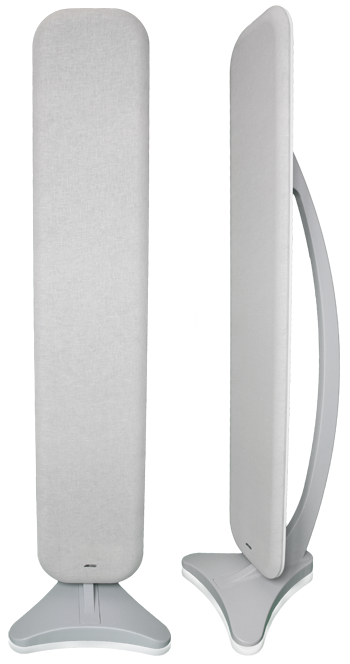 Not long after our absolute astonishment over the IPC Acoustic Energizers, was I fortunate enough to have another round of IPC products installed into my listening room. They included four EQ Panels and a Sound Power AC Conditioner. This opportunity took place about two weeks after living with five Acoustic Energizers which were so effective in my system, I couldn’t do anything except second guess the need for anything else. Without going into too much detail behind each product – Stephen Yan and Mike Silverton do a splendid job of that following these brief observations – I will state for the record that after placing four EQ Panels in my listening room (two behind my loudspeakers and two directly in front of them) and then inserting the Sound Power AC Conditioner brought about a musical encounter I had never experienced prior.
Not long after our absolute astonishment over the IPC Acoustic Energizers, was I fortunate enough to have another round of IPC products installed into my listening room. They included four EQ Panels and a Sound Power AC Conditioner. This opportunity took place about two weeks after living with five Acoustic Energizers which were so effective in my system, I couldn’t do anything except second guess the need for anything else. Without going into too much detail behind each product – Stephen Yan and Mike Silverton do a splendid job of that following these brief observations – I will state for the record that after placing four EQ Panels in my listening room (two behind my loudspeakers and two directly in front of them) and then inserting the Sound Power AC Conditioner brought about a musical encounter I had never experienced prior.
In fact, my first reaction was one of disbelief. Having five Acoustic Energizers installed for weeks should have prepared me for what was to come next. They did not. What I experienced was a sense of the floor coming up with gobs of low-energy detail. Dimensionality and stage width magically appeared on a level I had never witnessed. Closer to that of a IMAX film rather than that of an high-end stereo system. Details, super small ones I never knew existed, starting making their way through the low-end muck and mire revealing beautiful hidden notes and melodies. Enough to elicite an emotional wave of tears. Yes, I could not believe that something like this could be possible and that we might be the first to share the experience here in the western world. I cannot thank the designers at IPC and our own Stephen Yan enough.
Yep, I said it. I cried. You would too perhaps, if you love music as much as I do and heard bass articulation and integration into the midrange and high frequencies the way I felt it. I came to realize, that in terms of differences between the EQ Panels, Sound Power and the less expensive Energizers is: they (Energizers) start to work at the high-frequencies leading down into the midrange and midbass where their effectiveness begins to trail off. The EQ Panels and Sound Power AC Conditioner adhere to low-level information in particular giving the bass a sense of snap and dynamic property I would not have believed had I not heard it for myself.
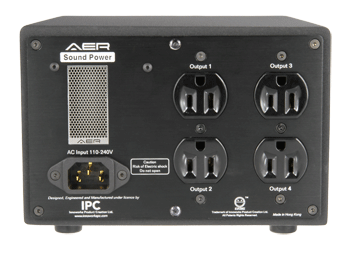 In a state of euphoria and disbelief, the next thing I did was make some near-hysterical phone calls. At close to midnight mind you. I must have called ten people. Fortunately, no one answered the phone except for one person – Key Kim, my travel partner and friend. He never doubted my experience. He knows me well enough to sense by the mere tone of my voice that something extraordinary had occurred. In all the years Key has known me, only twice, if memory serves me correctly, can I recall going off the deep end like this. The first time was when I first installed the Behold series of electronics back in the summer of ’05. The second times was the Laufer Teknik Memory Player in ’06 (and those very components still qualify as my reference today).
In a state of euphoria and disbelief, the next thing I did was make some near-hysterical phone calls. At close to midnight mind you. I must have called ten people. Fortunately, no one answered the phone except for one person – Key Kim, my travel partner and friend. He never doubted my experience. He knows me well enough to sense by the mere tone of my voice that something extraordinary had occurred. In all the years Key has known me, only twice, if memory serves me correctly, can I recall going off the deep end like this. The first time was when I first installed the Behold series of electronics back in the summer of ’05. The second times was the Laufer Teknik Memory Player in ’06 (and those very components still qualify as my reference today).
That was all the evidence Key needed to schedule a visit. His only request was that Bob Visintainer, President of Rhapsody and Music and Cinema, a high-end salon located in NYC, join him, for this chance encounter. “The more the merrier” was my response. Keep in mind, Visintainer who I have gotten to know over the past year also qualifies himself as a music lover first and foremost. The illustrious brands he carries – Goldmund, Raidho, Vivid and Kondo of Japan – serve up some insights as to his tastes for fine playback. Trying to impress him with a mere tweak might prove troublesome considering I had no clue as to his feelings for such oddities. However, in less than 30 minutes into the session, and with an assortment of CDs, most notably a sampler from Philip O’Hanlon that Visintainer dug out of his bag of music, did he then proclaim “this is perhaps the best sounding audio system I have ever heard! I so wanted to give Visintainer a huge hug. Not because he liked my sound (well, maybe a little bit), but more importantly because Visintainer didn’t let property and prestige distort his objectivity. Many dealers, importers and designers cannot hear anything beyond what they either sell, import or design. Visintainer is among the few breed of dealers whom I know who calls it like he sees it…not according to the profit margin.
On second thought, Visintainer could have been doing the politically correct thing by not being critical of me because I am writer? Maybe. But here’s what I found out later that same day. Visintainer was scheduled to go back to Key’s place and listen to some new Kondo gear. But halfway there, he abruptly asked to be let out of Key’s car upon entering into Manhattan via the Holland Tunnel, then jumped into a taxi and headed directly to his midtown apartment. Once there, he immediately phoned Norbert Heuser, IPC’s vice president. Visintainer subsequently placed a huge order on the spot and became a dealer.
Moreover, outside of Franck Tchang’s Acoustic System Resonators, Key Kim eschews all tweaks – including AC conditioners. He simply does not subscribe to all the crazy gizmo stories about tweaks affecting air molecules. That was until he heard the IPC products for a second time in Visintainer’s huge Goldmund rig some weeks later. Fast forward to present: Key’s currently living quite comfortably with four Acoustic Energizers and is slowing coming around to experimenting with more IPC products.
In short, the IPC EQ Panels and Sound Power AC Conditioner’s performance is the stuff of legend. I was so impressed I literally could not believe what I was hearing and had to call on the assistance of someone else. Yes, these devices will have you thinking you’re losing your sanity. I might be going crazy on my own but I doubt there is no such thing as mass delusion. It is in this regard that these reviews are done here in tandem and with regard to each product individually (and by a different individual). What else is there to say, except the IPC products have lifted the roof on what I thought was sonically possible from a two-channel high-end audio system. Easily, the most effective series of acoustic enhancing accessories I have encountered.
EQ Panels
 Not too long after Clement and I completed our double-review of the IPC Acoustic Energizer (christened the “canister” by CP – reviewed here), my esteemed publisher asked me for my thoughts on a closely related IPC product, the EQ Acoustic Panel. So while this is in a sense a “follow-up” review, it is not really about the same product but, as far as I can tell, a completely and radically different one.
Not too long after Clement and I completed our double-review of the IPC Acoustic Energizer (christened the “canister” by CP – reviewed here), my esteemed publisher asked me for my thoughts on a closely related IPC product, the EQ Acoustic Panel. So while this is in a sense a “follow-up” review, it is not really about the same product but, as far as I can tell, a completely and radically different one.
Semantics aside, perhaps a little chronology may be in order here. While I was reviewing the IPC Acoustic Energizer canisters (to recap, 2 of them in my room), Clement had already the good fortune of having four of the aforementioned IPC EQ panels sent to him for audition. So, even before the ink on my review of the canisters had dried, the fate of this review was already sealed. In short, if you only have time to read this far, the EQ panels are the best “accessory” I have ever tried in the last 20 years of my audiophile existence. And I have tried many. You may stop here now and go out to buy them.
For those who feel they need further and better particulars, here is the deal. The IPC EQ panels work on the same principle as the IPC canisters, but their effectiveness is multiplied several-fold. The design brief for the panels had huge acoustic spaces such as concert halls, theatres and recording studios in mind. As far as I can tell, the idea is to improve the coverage of the live sound and eliminate or reduce null points around the auditorium. Sound levels decrease by 6 dB for every doubling of distance it has to travel, but architects primarily tackle the problems of direct sound propagation by the sole criteria that it should not be blocked by other audience members. For an audience member who is seated furthest away from the source of the sound (usually the stage), assuming that overly long reverb times are adequately addressed (anything above 50 ms means a discrete echo, which is bad), the level and quality of the direct sound will be lower than for one seated closer to the stage. That is why we have seats that are priced differently. With judicious placement of EQ panels around the auditorium, I can certainly imagine this being a new and powerful tool in the acoustic engineers’ arsenal to bring about higher quality sound to the “cheap seats”. Oh dear, I hope this is not an excuse for concert halls to start charging more… enough said.
In my earlier review you can read about the designer Vian Li’s proprietary PVA technology. Vian Li was first driven to develop this technology while investigating why an 8” woofer sounded better in the same environment than a 12” woofer, even though the latter was measurably better. His conclusion was that the energy loss from the bigger woofer to the listener’s ear, through the air, was the main culprit. He reasoned that if he could minimize this loss, he would restore the true sonic potential of any sound system in any room. Solving the same problems in a public listening space poses even greater challenges, and the EQ panels were designed to meet these challenges.
Each panel measures about 53 x 1320 x 49 mm – (10″ x 52″ x 2″), and is quite unwieldy at 9 kg each. It looks like an elongated Chiclet and is covered from head to tail in an off-white acoustically-transparent cloth. They either hang off a supplied stand, reminiscent of those curved banana holders, or wall-hanging brackets. At the back, near the bottom, are 3 user controls; an on-off switch, a Damping and a Fine-Tuning knob. None of these can be intuitively used. The on-off switch may seem self-explanatory enough, but the local dealer informed me that the EQ panel actually does not run on electricity (whether AC or DC, unlike the AE units). There are no batteries to run down or change. It also continues working for up to half an hour after being switched off. Perhaps it absorbs and somehow magnifies and releases the signals physically presented to it? Again, as per the canister units, details are scarce. The Damping knob is supposed to increase or decrease the quantity of sound waves reflected by the panel, and the Fine-Tuning knob is meant to be used “by professional engineers” according to the manual, so it did not bother to elaborate further for non-professional engineers like me. I could almost hear the sniff.
Placing a pair of EQ panels in my room, for me, was a no brainer. As before, the corner placements of my AN-E/SpE/HE speakers preclude the EQ panels being located behind them. No other corners are available, and the side walls are taken up by my big Audio Reference monoblocks (one along each wall), and the rest of the equipment. The only space available was on either side of the loudspeakers. I tried using the panels in the first reflection positions in place of the usual RPG diffusors, but for some reason they did not work as well as when they were placed on the other side of the speakers, ie along the front wall. That’s where they stayed for the rest of my time reviewing them. Both Damping and Fine-Tuning knobs were set at the half-way mark and I never felt the need to experiment with them further.
ZEN MYSTERY: WHAT IS THE SOUND OF NO EQUIPMENT?
We have all read reviews where a new product sounds like the equipment “got out of the way of the music”. To adopt the old chestnut, that’s exactly what the panels did. They vastly increased my sense of listening to no equipment at all, just music happening in mid-air, and with nothing between you and the music, much in the way a pair of extremely good headphones might sound. That it does this without being physically plugged into the existing system, or even being plugged in at all, makes it all the more remarkable.
The factors that add up to an almost uncanny sense of listening to headphones are myriad, but can probably be summarized into this one thing; low-level interstitial detail. Nowhere was this more forcefully brought to my attention than in the first of Schoenberg’s “Six Little Piano Pieces Opus 19”, played by James Boyk (Performance Recordings PR-4). Many audio systems let you hear a chord when the pianist presses down the keys, and the better ones let you hear when the pianist releases the chord. But what the EQ panels bring to the party is clarity on the timing of the release, so that you can hear that Boyk did not lift his left hand entirely, but finger by finger. You could – if you were anal retentive enough – literally identify exactly which key was released in what order (D natural and Eb, leaving G natural and B natural in place while he reaches over to play the ritardando figure in measure 11, and yes, I do have a life). It is not essential to have this level of detail to enjoy any piece of music of course, but having access to it enhances the illusion of the musician playing in front of you, giving your mind a much easier time.
When a wind player, such as a clarinetist plays, his fingers lift and close over keys and holes. A sound is fully formed within the clarinet when the fingers are properly in position and a column of air vibrates the reed and fills the instrument. However, in legato playing, in between each fully formed sound or note, there are many half tones, overtones, and harmonics in those micro-seconds when a pad or finger half-closes a hole. When you are able to hear these interstitial sounds in a recording, the clarinetist is right in front of you, right now, and for audio nerds like me that is downright exciting. Those who crave a more X-rated experience can put on their (insert your favorite sultry bedroom-voice vocalist) recording and be in the same room with (insert your favorite sultry bedroom-voice vocalist).
I don’t want to give the impression that the panels are all about retrieving copious amounts of detail. This they do, and very well indeed, but their other tricks are just as marvellous. As a whole sonic picture, the panels create that matchless transparency which sets a new benchmark for me. My previous system, which was housed in a different (larger) room, created a superb image with loads of detail, but I was only ever able to achieve a living, breathing, breath-taking lower-mid transparency with the best Reference Recording HDCD discs turned out by the legendary Dr Keith Johnson. Now, even with non-audiophile vinyl of some vintage, and the IPC EQ panels, I get that same KJ-signature transparency and coherency, not just in the lower mids, but right across the  frequency range from lowest to highest notes. A case in point is the duet from “Norma” in Act 1 Scene 2 (Duets from Norma and Semiramide by Joan Sutherland and Marilyn Horne conducted by John Bonynge Decca SET456). One moment you are carried along by the pure, soaring, almost cinemascope bel canto lines, and the next moment without warning, the LSO kicks in with a fff diminished 7th chord that knocks you off your seat. The contrast in frequency, dynamics and texture is brilliant and supremely thrilling, reminding one why Bellini’s opera is often considered his masterpiece, and why only the most assured and technically gifted sopranos would even consider attempting the role.
frequency range from lowest to highest notes. A case in point is the duet from “Norma” in Act 1 Scene 2 (Duets from Norma and Semiramide by Joan Sutherland and Marilyn Horne conducted by John Bonynge Decca SET456). One moment you are carried along by the pure, soaring, almost cinemascope bel canto lines, and the next moment without warning, the LSO kicks in with a fff diminished 7th chord that knocks you off your seat. The contrast in frequency, dynamics and texture is brilliant and supremely thrilling, reminding one why Bellini’s opera is often considered his masterpiece, and why only the most assured and technically gifted sopranos would even consider attempting the role.
Bass is especially well served by the panels, sounding effortlessly subterranean. It seems to erupt from the floor all around and underneath me, instead of rolling out from some predetermined space towards the listening position. Kettle-drum blasts in Darius Milhaud’s “Second Concerto for Two Pianos and Percussion” (Musical Heritage Society MHS 854) or Wolfgang Rihm’s “Sub-Kontur” (SWF-54 Ernest Bour conducting the Sinfonieorchester des Sudwestfunks) have never been a more visceral, full-bodied experience. Whatever the strengths of your system, the panels will multiply and enhance. Weaknesses are either ameliorated to a large extent, or left as they are. In business-speak, this is all upside, no downside. Quite how the panels achieve this is a Zen mystery, for how does an inanimate object decide what is good in a system and what isn’t? In a sense, isn’t that the ultimate, but rarely realized goal of every piece of hifi equipment ever made?
CONCLUSIONS
I could go on with example after musical example illustrating how good the EQ panel is, but that would just be gilding the lily. And what a lily this is. The EQ Acouztic panel is not cheap, but if you consider it not as a mere accessory but as a system component, which it truly is, it will seem like a bargain.
I feel I have to find something negative about the panel to justify my existence as a reviewer. Ok, it is big, heavy and has a very low WAF. And with a low- to mid-quality system, this panel may not seem to justify its asking price. But remember, it will grow with you. The better your system and room becomes, the better it will perform. Even if you own a room the size and quality of the Bayreuth Festspielhaus, you will never outgrow the panel (you just need more of them), so it is a purchase for a lifetime. You may get one and enjoy tremendous benefits therefrom, but a pair is de rigeur, IMHO. If you have the space and the wherewithal to do so, the more you get, the merrier you will be.
A postscript. My car has a reverse warning alarm mounted somewhere inside the vehicle, at the back of the cabin. While returning the EQ panels to the dealer, I shifted into reverse and started to back into a lot with the panels loaded up behind me. Suddenly, I heard a LOUD beeping sound which I hadn’t heard before, as if coming from somewhere next to me. For a few seconds I thought it was a new engine alarm, and flicked my eyes back and forth the dashboard, until I remembered my cargo, and checked… Yes, they were still switched “on.” I close my case.

Sound Power AC Conditioner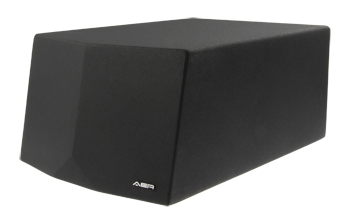 It doesn’t often happen that an audio journalist is among the first in his corner of the world to celebrate a remarkable product line. Stephen Yan in Singapore stole the march with his IPC Acoustic Energizer report, with Clement Perry’s addendum. Both can be fairly described as raves. My own AE remarks are likewise extravagant. I concluded with “This stuff leaves the premises over my dead body.” Time has done nothing to blunt my enthusiasm.
It doesn’t often happen that an audio journalist is among the first in his corner of the world to celebrate a remarkable product line. Stephen Yan in Singapore stole the march with his IPC Acoustic Energizer report, with Clement Perry’s addendum. Both can be fairly described as raves. My own AE remarks are likewise extravagant. I concluded with “This stuff leaves the premises over my dead body.” Time has done nothing to blunt my enthusiasm.
So, in the spirit of charmed privilege, some thoughts about IPC’s Sound Power line conditioner, beginning with the how of comparison.
Bearing in mind that in the Off position, depending on the room and whatever other conditions obtain, an Acoustic Energizer’s influence is said to linger from moments to days. As a bone-lazy sybarite, I have no wish to quantify that. Enough that my AE quintet has been off since yesterday. The plan is to play a disc I’m familiar with, remove my BlackNoise line conditioners as quickly as possible and install the Sound Power, likewise ASAP, in order to determine what the SP accomplishes on its own, followed by what differences the SP makes with my five AE units and Disc Energizer back in the fold. Our audio memories are short and unreliable – and available to prejudice. I’ll do my best to be fair.
 I began the morning of the Sound Power’s arrival by playing a Shostakovitch string quartet I’d been listening to recently. Again, the Acoustic Energizers had been off for a tad longer than a day, but not removed from the room. Nor did I use the Disc Energizer. I should mention too that over a week ago I’d removed the three Acoustic Revive virtual grounds attached to my amps and CDP, not that that made much of a difference. Four Acoustic Revive room-treatment panels remain on the wall behind the system. They’re too beautiful to take down.
I began the morning of the Sound Power’s arrival by playing a Shostakovitch string quartet I’d been listening to recently. Again, the Acoustic Energizers had been off for a tad longer than a day, but not removed from the room. Nor did I use the Disc Energizer. I should mention too that over a week ago I’d removed the three Acoustic Revive virtual grounds attached to my amps and CDP, not that that made much of a difference. Four Acoustic Revive room-treatment panels remain on the wall behind the system. They’re too beautiful to take down.
(The impression that IPC knows what it’s doing persists with the Sound Power’s packaging: sturdy, cleverly designed and elegantly understated. These folks have no use for bling.)
With the Sound Power installed and a few discs played, I perceived an effect similar to that of my five AE units, albeit to a slightly lesser degree. It did occur to me that were one to acquire a single IPC component, the Sound Power would be a good choice. It enhanced the stereo image’s dimensionality, vividness and dynamic finesse against a backdrop of utter silence.
IPC has given the picotechnology behind its audio devices a street name: Euphoria. Immodest and often delusional self-promotion in the audio biz has a long and tiresome history. Here, not. “Euphoria” puts it nicely. With the five AE units and Disc Energizer back in play, applying the moment’s mot juste, this euphoric listener is having a hell of a time.
Prior to the SP’s arrival, I had paired my AE units behind the speakers, with the fifth midfloor between me and the sound system. The Sound Power and four Acoustic Energizers at the system-side of the listening room struck me as an overabundance. I broke up the pairs by placing an AE unit on either side of my perch (a couch) and liked what I heard. Not on the order of you-could-have-knocked-me-over-with-a-feather, but a little better. I won’t embarrass myself or burden you with a detailed account of my obsessive-compulsive AE shufflings.
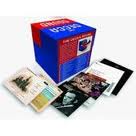 This IPC assemblage produces a remarkably vivid and therefore excruciatingly revealing effect. It does quite literally clear the air (see the website for more about that). Number 27 of a 50-disc compilation, The Decca Sound (Decca 478 2826), Ute Lemper / Berlin Cabaret Songs, recorded in 1996, reveals the singer’s upwardly-tipped mic against the Matrix Ensemble’s softer-sounding backup very much in their own space, the singer most decidedly in hers. Perceptions of this kind can be a little disconcerting (there’s a pun there if you want it) and a whole lot of fun if you’ve an audiophilic turn of mind. This style of recording is not to my taste. I listen largely to classical with occasional side-trips to edgy jazz and the wide world of whatever. Almost all of what I listen to is recorded ensemble – performances in one space conveying an impression of real-life cohesion. Studio concoctions aim for different effects, now made all the more obvious. I’m in closer touch with what’s on the disc. IPC cracks the whip, the protons snap to!
This IPC assemblage produces a remarkably vivid and therefore excruciatingly revealing effect. It does quite literally clear the air (see the website for more about that). Number 27 of a 50-disc compilation, The Decca Sound (Decca 478 2826), Ute Lemper / Berlin Cabaret Songs, recorded in 1996, reveals the singer’s upwardly-tipped mic against the Matrix Ensemble’s softer-sounding backup very much in their own space, the singer most decidedly in hers. Perceptions of this kind can be a little disconcerting (there’s a pun there if you want it) and a whole lot of fun if you’ve an audiophilic turn of mind. This style of recording is not to my taste. I listen largely to classical with occasional side-trips to edgy jazz and the wide world of whatever. Almost all of what I listen to is recorded ensemble – performances in one space conveying an impression of real-life cohesion. Studio concoctions aim for different effects, now made all the more obvious. I’m in closer touch with what’s on the disc. IPC cracks the whip, the protons snap to!
The atmosphere’s abovementioned particles remained commendably disciplined with respect to the 50-disc set’s second disc, España. This was in its day – 1956 – a sonic blockbuster (to use the term then in vogue), and is today, thanks in good measure to this IPC abundance, no less revealing of its period’s limitations: a congested high end that really doesn’t go all that high, a commensurately tubby low end and somewhat muffled midrange. Not that I’m complaining. It’s fun to so clearly experience a celebrated recording’s old-timey charms. The program’s original LP iteration and hi-fi playback’s relatively primitive frontends produced a rather different and,no doubt, pleasurable listening experience. (The program: Chabrier’s España, Rimsky-Korsakov’s Capriccio espangnol, Granados’ Andaluzia, one of Moszkowski’s Spanish Dances, and as a CD extra, Tchaikovsky’s Violin Concerto, Ataúlfo Argenta conducting the London Symphony Orchestra, Alfredo Campoli, violin.)
 And we come to a two-disc set I’ve long treasured, only to discover yet deeper beauties. Die Rosenkranz-Sonaten (aka Mystery Sonatas or Rosary Sonatas) of Heinrich Ignaz Franz Biber (1644-1704), the finest violinist of his time, now play within an airier, more lifelike space. This wonderful music is also noteworthy for the violin’s scordatura (unorthodox) tunings. The 1990 performances with violinist Reinhard Goebel to accompaniments of cello, lute, harpsichord and organ (Deutsche Grammophon 431656-2, two discs) are well worth the search.
And we come to a two-disc set I’ve long treasured, only to discover yet deeper beauties. Die Rosenkranz-Sonaten (aka Mystery Sonatas or Rosary Sonatas) of Heinrich Ignaz Franz Biber (1644-1704), the finest violinist of his time, now play within an airier, more lifelike space. This wonderful music is also noteworthy for the violin’s scordatura (unorthodox) tunings. The 1990 performances with violinist Reinhard Goebel to accompaniments of cello, lute, harpsichord and organ (Deutsche Grammophon 431656-2, two discs) are well worth the search.
Disc one of a five CD set, Mstislav Rostropovitch, The Complete Decca Recordings (Decca 478 3577), released in 2012, offers, in this listener’s opinion, some of the most endearing moments on disc: the incomparable Russian cellist, with composer Benjamin Britten at the piano, performing Schubert’s Sonata for Arpeggione and Piano and Schumann’s Five Pieces in Folk Style. (The cello-like arpeggioneis one of music’s discards. A museum somewhere has one on display. The sonata is today performed on the modern cello.)
What’s more gratifying than a recording’s heightened presence? Disc after disc, it’s the same story. Much of whatI’ve been listening to occupies a fuller, more involving space. Good recordings of whatever age – these Rostropovitch performances date from the early Sixties – are all the more enjoyable, the period’s technical limitations notwithstanding. On the negligible downside, a mediocre-to-crummy production’s deficiencies are likewise laid bare. But enough of ineptitude. Britten’s Suites Nos. 1 and 2 for solo cello (disc two) put Rostropovitch in the listening room about as effectively as two-channel sound is likely todo.
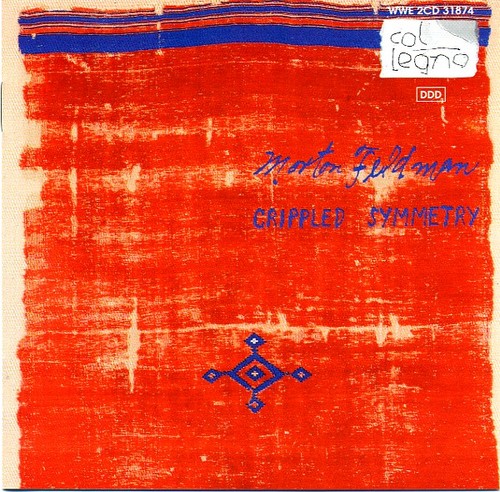 A 1991 hatNOW series two-CD set of Morton Feldman’s Crippled Symmetry, for flute / alto flute / bass flute (Eberhard Blum); piano / celesta (Nils Vigeland); glockenspiel / vibraphone (Jan Williams), an incomparably beautiful performance recorded by West-German Radio, Cologne, counts among my domestic treasures. To an already splendid recording, the IPC assemblage applies an extra measure of spacious luminosity: thrilling is not too strong a term. (hat ART 2-6080)
A 1991 hatNOW series two-CD set of Morton Feldman’s Crippled Symmetry, for flute / alto flute / bass flute (Eberhard Blum); piano / celesta (Nils Vigeland); glockenspiel / vibraphone (Jan Williams), an incomparably beautiful performance recorded by West-German Radio, Cologne, counts among my domestic treasures. To an already splendid recording, the IPC assemblage applies an extra measure of spacious luminosity: thrilling is not too strong a term. (hat ART 2-6080)
I played many more discs than the few I mention here and believe I’ve offered a fair description of what these things do: in a word, the Disc Energizer, Acoustic Energizers and Sound Power deliver pleasure. (When the company designs an acoustic panel that looks less like an ironing board I’d be pleased to take it on.
For an opinion by a better informed audiophile, www.youtube.com/watch?v=T1GUBx75-fk

***
EQ Panel: Price $2,500.00 USD ea
1,320 x 253 x 60 mm / 52” x 10” x 2.4”
5 kg / 11 lbs – without stand
Does not require external power supply
On-off switch, Phase control and Damping control
1,200 x 367 x 400 mm / 47.2” x 14.4” x 15.7”
4 kg / 8.8 lbs
IPC Sound Power, $2,500.00 USD
Dimensions: 457 x 345 x 290mm / 18 x 13.6 x 11.5 inches
Weight: 7 kg / 15.4 lbs
Rated power: 4 kW
1 input, 4 outputs
Warranty: 3 years
Stereo Times Masthead
Publisher/Founder
Clement Perry
Editor
Dave Thomas
Senior Editors
Frank Alles, Mike Girardi, Russell Lichter, Terry London, Moreno Mitchell, Paul Szabady, Bill Wells, Mike Wright, and Stephen Yan,
Current Contributors
David Abramson, Tim Barrall, Dave Allison, Ron Cook, Lewis Dardick, John Hoffman, Dan Secula, Don Shaulis, Greg Simmons, Eric Teh, Greg Voth, Richard Willie, Ed Van Winkle, Rob Dockery, Richard Doron, and Daveed Turek
Site Management Clement Perry
Ad Designer: Martin Perry






Be the first to comment on: IPC Acoustic EQ Panels and Sound Power AC Conditioner